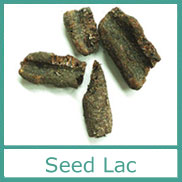Resinous incrustation produced by the female of the lac insect (Laccifer lacca), which eventually covers the twigs of trees in India and the Far East. The gathered twigs are known as stick lac, and yield a useful crimson dye; shellac, which is used in varnishes, polishes, and leather dressings, is manufactured commercially by melting the separated resin and spreading it into thin layers or flakes. Lac is the resinous secretion of a microscopic tiny insect, popularly known as Laccifer Lacca. The lac insects belongs to the family of a scale insect and mealy bugs of the super family “coccoidea”.

On average three hundred thousand insects produce one kilogram of lac resin. Sticklac is the basic raw material. Sticklac is first crushed and sieved to remove sand and dust. It is then washed in large vats again and again and at the same time rubbing the lac against the sides of the Vat to break open the insect bodies and dissolve the coloring matter in water. The lac thus cleaned is spread on large, clean, open air floor to dry. After drying, it is winnowed and sieved to get the commercial variety of Seedlac. Seedlac is mostly used for conversion into Bleached Shellac and different types of Shellac.
APPLICATION
Natural materials have been extensively used in the field of drug delivery because they are readily available, cost-effective, eco-friendly, capable of a multitude of chemical modifications, potentially degradable and compatible due to their natural origin. Past research therefore studied and acknowledged various natural gums like agar, konjac, guar gum, chitosan, xanthan gum, sodium alginate and locust bean gum for potential pharmaceutical and biomedical applications. These particulars explicate the rationale why the proposed article concerns the evaluation of natural gums for sustained drug delivery.
Gum copal (GC) is a natural resinous material of the plant Bursera bipinnate (family Burseraceae ). It has been used as a raw material for varnish because it produces glossy films with good weather protection properties. It has been used as a pigment binder in varnishes due to its excellent binding properties. It has been mainly used as an emulsifier and stabilizer for the production of color, paints, printing inks, aromatic emulsions, and meat preservatives. Interestingly, GC was also used as medicine for several different ailments such as in the treatment of burns, headaches, nosebleeds, fever, stomachache, and in the preparation of dental products, and as a remedy for loose teeth and dysentery.
Grades of Seed Lac
- Genuine Bysacki
- Fine Bysacki
- Manbhum Fine Bysacki
- Kusumi
- Golden Bysacki
- Golden Kusumi
Genuine Bysacki
